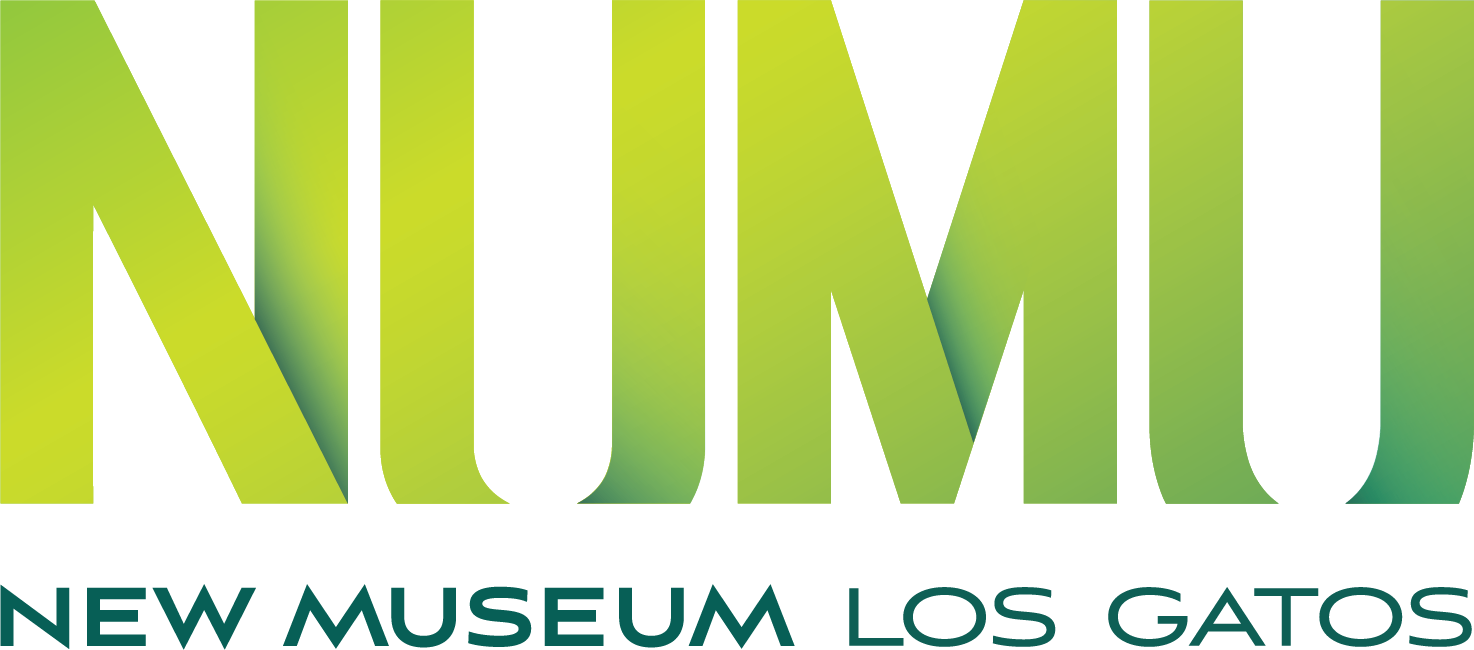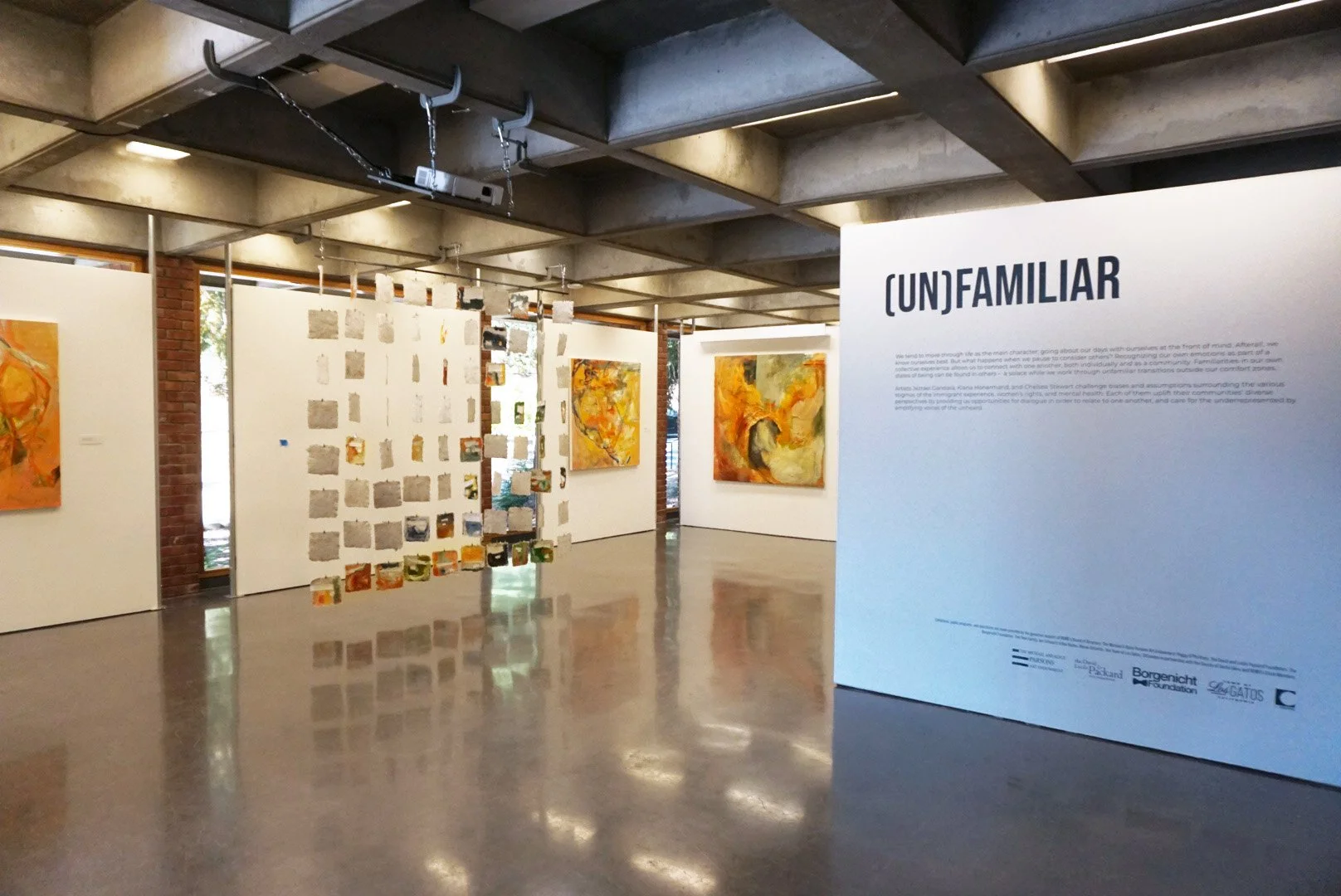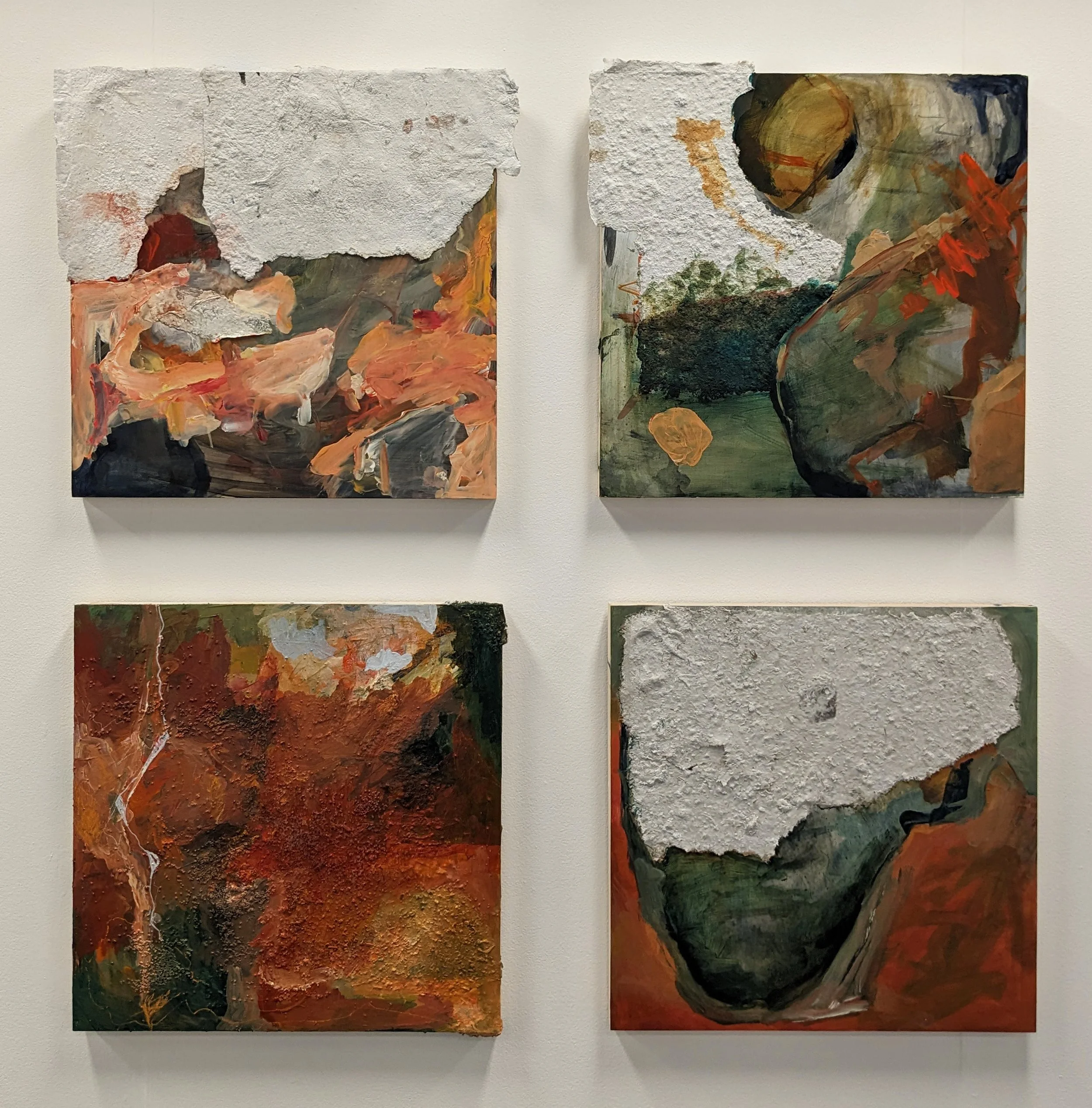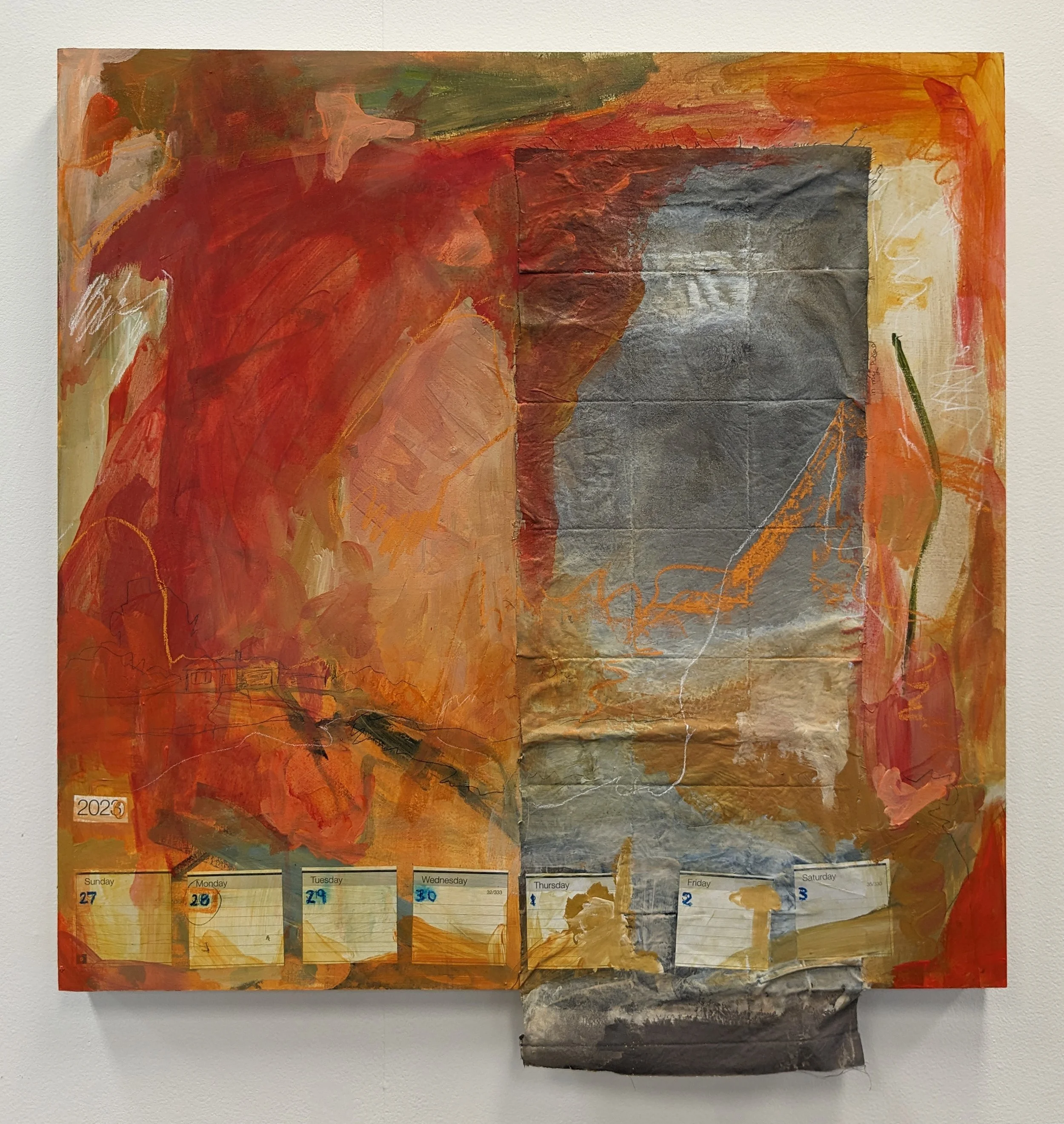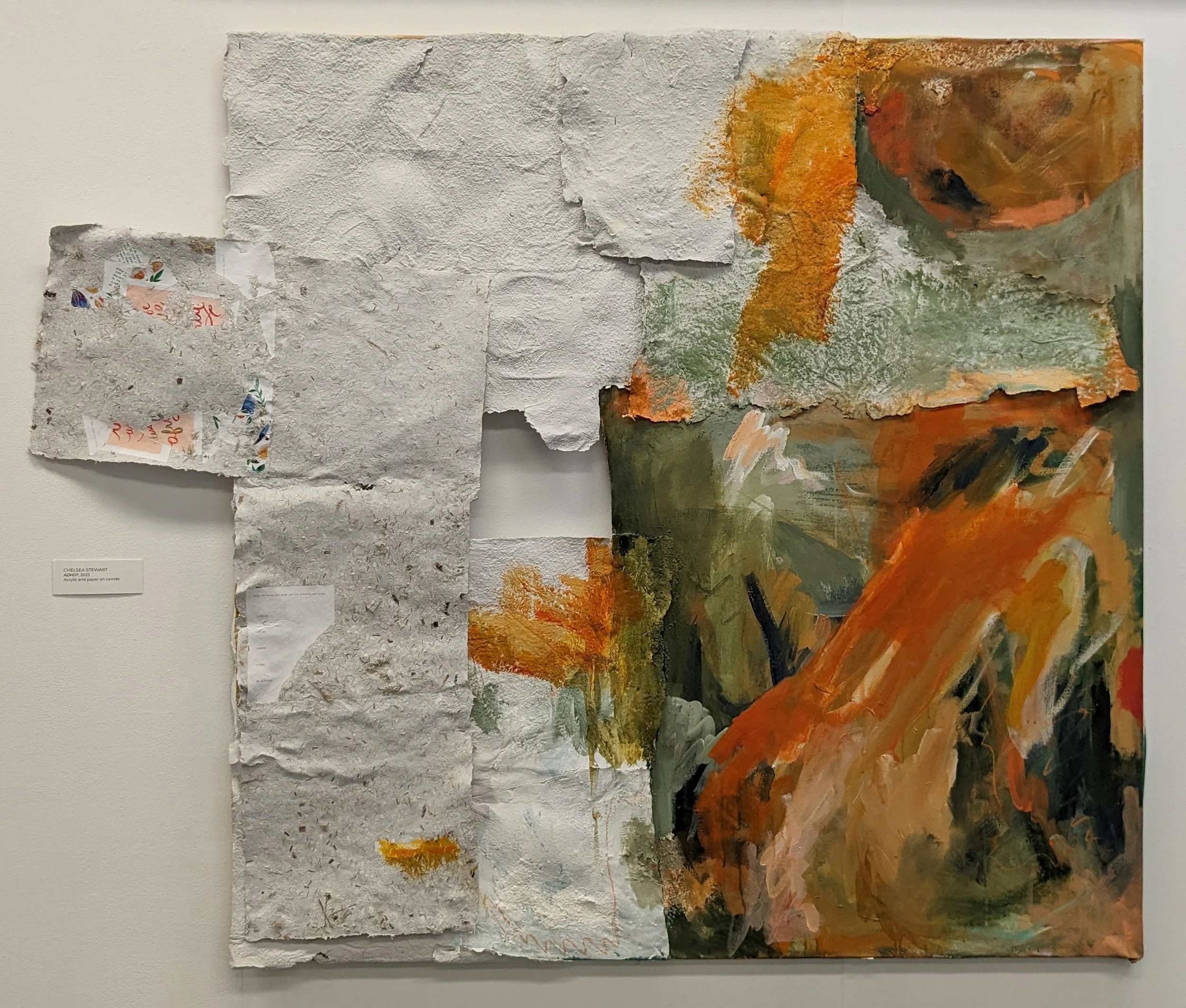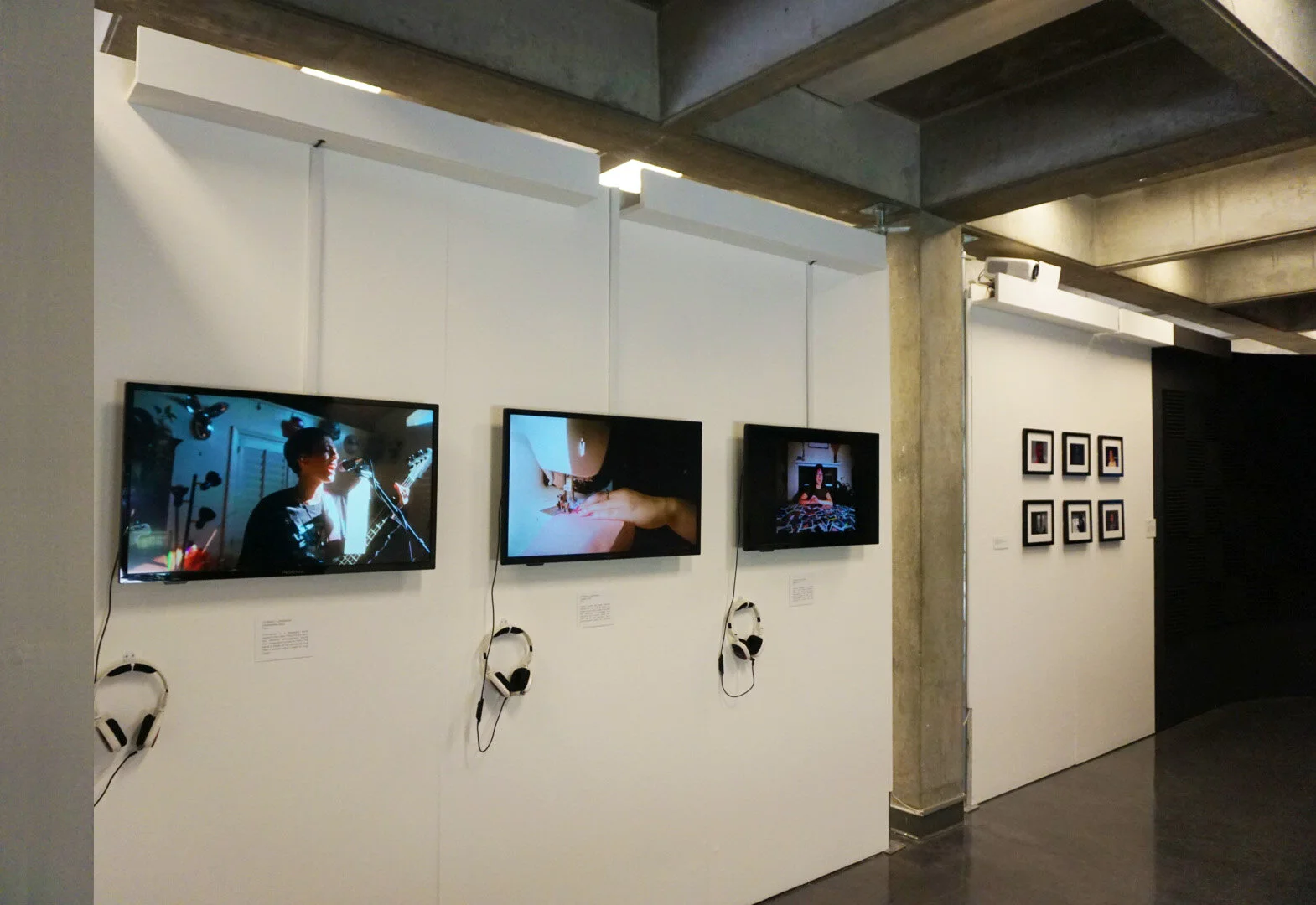Thanks for visiting New Museum Los Gatos (NUMU)! Below you will find images of the different objects displayed in the exhibition and related text for easier accessibility.
If you have any questions, don’t hesitate to ask anyone from the NUMU staff.
Jump to: Kiana Honarmand, Chelsea Stewart, Jezrael Gandara
(Un)familiar
We tend to move through life as the main character; going about our days with ourselves at the front of mind. After all, we know ourselves best. But what happens when we pause to consider others? Recognizing our own emotions as part of a collective experience allows us to connect with one another, both individually and as a community. Familiarities in our own states of being can be found in others – a solace while we work through unfamiliar transitions outside our comfort zones.
Artists Jezrael Gandara, Kiana Honarmand, and Chelsea Stewart challenge biases and assumptions surrounding the various stigmas of the immigrant experience, women’s rights, and mental health. Each of them uplifts their communities’ diverse perspectives by providing us opportunities for dialogue in order to relate to one another and care for the underrepresented by amplifying the voices of the unheard.
Kiana Honarmand
About the Artist
Kiana Honarmand was born and raised in Iran. She currently lives and works in the Bay Area, having had artist residencies at Root Division in San Francisco, the Cubberley Artists Studio Program in Palo Alto, and the San Jose Museum of Quilts and Textiles. She has exhibited in solo and group exhibitions in Tehran, Iran and throughout the United States.
Kiana Honarmand’s work addresses issues related to her cultural identity, violations of women's rights in Iran, censorship, surveillance, and the Western perception of SWANA (South West Asian, North African) identity. Kiana studied photography at the University of Tehran, Iran, receiving an education rooted in tradition that honed her technical skills. It was when she immigrated, and continued her education, in the United States in 2012, that she had the opportunity to explore interdisciplinary arts. “I became really curious because I had never done any of these things. I started really experimenting and broadening my horizons.” As a result, her practice became conceptually driven, using digital fabrication tools and traditional methods of craft to share stories of immigration, censorship, and the experience of women in patriarchal Iran. “This is why I need art. Because I am not very good at expressing things through words. The art is out of necessity at this point.”
Kiana Honarmand, On Edge (2017), Fiberboard, steel, light, shadow
Drawing inspiration from the rich tradition of concealing critical commentary within Persian poetry and art, On Edge honors the unwavering spirit of Iranian women in their fight against oppression. In the elegant curves of Persian calligraphy, politically-charged writings are transformed into patterns. And while Persian script may evoke fear and unease in the West, these bold patterns seize the space while challenging preconceptions.
Much like Iranian women who have defied the oppressive and unjust laws imposed upon them by their government, this work radiates resilience despite limitations. An inner light shines through constraints and boundaries, breaking free from the confines of the metaphorical cage, illuminating not only the immediate surroundings but also embracing anyone near it, inviting the viewer to become part of the experience.
Kiana Honarmond, Unfettered, 2023, Laser-cut felt
Stylized Persian script of Iranian propaganda relating to laws put upon women, in particular the mandatory, and brutally enforced, wearing of hijabs.
Kiana Honarmond, Mending Unhealing Wounds, 2020, Video projection on chiffon.
Performance by the artist. A protest against the many unjust and oppressive laws imposed on women in Iran.
Chelsea Stewart
About the Artist
Chelsea Stewart was born, and is currently based in, San Mateo County. She is currently attending San Jose State, working toward an MFA in Spatial Arts. Chelsea completed a residency in the Cubberley Artist Studio Program in Palo Alto and, while being a working artist, is also the Gallery Manager at the Pamela Walsh Gallery in Palo Alto.
Artist Statement
Chelsea’s work serves as a vehicle to encourage discussion of the social attitudes and narratives surrounding mental health. Through explorations of composition, scale, process, and mental health, Chelsea constructs large-scale abstract paintings and paper installations that examine relationships between the human mind and body. “I want to make something that reflects my own personal experience, using these elements to say more about my life. I wasn’t sure how to express it because the topic of mental health is so delicate, similar to papermaking materials. But when the delicate fibers interlock, you create a strong piece of paper. I see a beautiful mirroring of papermaking to mental health as a whole, because while people can be delicate, people are also so tough and resilient.” In her studio, Stewart dances with a brush in each hand, pushing paint together before it has a chance to dry. Her impulsive process leads her to work on five to six pieces at a time, moving fluidly from one to the next.
Chelsea Stewart, At Its Core, 2023, Acrylic and paper on canvas
Chelsea Stewart, What do you admire?/What do you wish people knew?/What do you admire? (2023), Handmade paper, community input
This paper installation draws from stories of mental health – anxiety, depression, and the like – of friends, family, and strangers. Communicating these narratives through art with a goal to normalize these issues in the every day and finding the positives and the untold experiences or benefits that can be derived from having a mental health condition. What are the things we don’t share every day, the things we wish people would know, the things we think we are the only ones that experience?
Through an open social media survey, the artist collected over a hundred responses from people within this region and beyond. These people shared their stories and perspectives on their mental health, answering three questions: What do you wish people knew? What do you admire? How is your anxiety a “superpower” in your day to day? The artist then curated the responses and transferred them onto homemade paper, personalizing each piece with process painting. Together, the majority of the finished pieces form this installation for people to read, and to connect and relate.
Warning: Messages contain references to anxiety, depression, panic attacks, suicide, and eating disorders.
Chelsea Stewart, Scribbles, 2023, Acrylic on canvas
Chelsea Stewart, Untitled, 2023, Acrylic and paper on canvas
Top left: Chelsea Stewart, Back to Basics, 2023, Acrylic and paper on wood panel
Bottom left: Chelsea Stewart, Back to Basics 2, 2023, Acrylic, paper, and beads on wood panel
Top right: Chelsea Stewart, Untitled (Ch 2), 2021, Acrylic and paper on wood panel
Bottom right: Chelsea Stewart, Opening Up, 2021, Acrylic and paper on wood panel
Chelsea Stewart, Routine, 2023, Acrylic, paper, and fabric on canvas
Chelsea Stewart, Today Was A Good Day, 2023, Acrylic and paper on canvas
Chelsea Stewart, ADHD?, 2023, Acrylic and paper on canvas
Chelsea Stewart, One of Those Days, 2023, Acrylic, paper, and beads on panel
Chelsea Stewart, RUT, 2023, Acrylic and paper on canvas
Chelsea Stewart, Now & Then, 2023, Acrylic, paper, and fabric on canvas
Chelsea Stewart, She Needs a System, 2023, Acrylic and paper on wood panel
Chelsea Stewart, What Makes Me Nervous, 2023, Acrylic and paper on canvas
Chelsea Stewart, It Is Something You Lost… Your Ideal Future, 2023, Acrylic and paper on canvas
Chelsea Stewart, Figuring it All Out, 2023, Acrylic, paper, and beads on canvas
Jezrael Gandara
About the Artist
Jezrael Gandara, originally from the border city of El Paso, TX, is a filmmaker currently based in San Jose, CA. Seeking to explore unique stories, his work is typically intertwined with themes of culture, race, identity, religion, and philosophy. He specializes in visual poetry, trying to communicate the deep essence of a message with interpretive imagery. He studied Digital Media Production at the University of Texas, at El Paso.
The purpose of Jezrael Gandara’s work is to create films that reflect an authentic portrait of the Latino community. “The root of my process is learning about the philosophy of their art or how they see the world. My biggest interest is providing an accurate image that people can see themselves in.” These moving pictures portray an intimacy and an identity that is underrepresented in contemporary cinema. As he gravitates toward stories he can relate to, such as being a Latino man in America and growing up around immigrant culture, these intimate portraits of brown individuals, uplift and highlight the beauty they hold. Jezrael’s work straddles the line between documentary and art, encouraging his subjects to communicate their honest feelings. “There are parts of San Jose that remind me of El Paso, and it makes it feel like home. I hope my work can make an impact within the community by helping share its stories.”
Jezrael Gandara, Nomas ando en la calle (2023), Film
Take a walk down Jezrael’s neighborhood and familiarize yourself with the sounds and textures of a small East San Jose neighborhood.
This video contains no sound.
Jezrael Gandara, Chilindrina (2022), Film
Chilindrina is a shoegaze band based in San Jose CA. They bring a dark but dreamy atmospheric sound that would make a perfect score for a film. The band is made up of individuals that have a passion and a need for loud music.
Transcript:
Um, Chilindina is like kind of the result of me growing up in high school off of bands off 4AD and, uh, Pavement, and like, Helium, and Daisy Chansaw and, um, a lot of, like, you know, Cocteau Twins, and Depeche Mode, and things like that. The Cure, a lot. These were kind of like bands that early on inspired me to want of, like, make these kind of similar sounds and I’d always wanted to kind of do things like that, that are a little bit more, kind of, like, dark and atmospheric and kind of, like, creepy and-
[Microphone sounds, chiming, whining noise]
Um, so when you get called Chilindrina as a kid, it’s not a good thing. You’re pretty much being called a crybaby, because the character, uh, that’s named after, is from a show from Mexico and she’s known to be a crybaby. So if you get called a Chilindrina, it was pretty much being, you’re like her, like, you’re a crybaby. So, when you’re playing kickball and you’re in fourth grade, and some kid called me, like, Chilindrina and wouldn’t stop, and I told him, like really nicely, don’t call me that and then I ended up getting really mad and I ended up throwing a chair to the kid.
[Music]
Directed by Jezrael Gandara. Director of Photography, Aaron Sarmiento. @soychilindrina.
Jezrael Gandara, Lorena (2022), Film
Lorena Cortez has been sewing clothes for the past 12 years. Her beautiful unique style has made many artists happy with their onstage outfits. She lives her mother and grandmother's legacy by stitching each piece of cloth together. She reflects on the warm memories of sewing she had with her mother.
Transcript:
[Funky music]. Lorena. A cinematic portrait of a Latina fashion designer.
I take my sketch to the dress form. I lay some muslin fabric on the torse of my mannequin and center it. Using my hands, I smooth it over from one side to the next and pin as I go. Any parts that create tension are clipped to keep the fabric as smooth as possible. Next, it’s time to transfer my drape to paper to create the pattern. I lay the fabric on the pattern paper and start tracing lines to transfer them. Never forget to add your seam allowance to ensure a perfect fit. I cut out the pattern pieces then lay them on my fabric. I selected a mid-weight denim with a gradient reminiscent of the sunset. I cut each piece out carefully making sure it’s all accurate. One mistake can throw off the whole garment.
[Clicking, film noises, whirring.]
[Upbeat music] LORENA.
[Distorted] Introducing Ruby Rae Clothing. Quality guaranteed. If you can imagine it, she can make it. Once you place your order, you will hear from Riby herself who will then gather your measurements, preferred colorways, and analyze fabrics. The best in the Bay Area. Why shop fast fashion when you can support small and create a one-of-a-kind garment fit just for you? You won’t regret it! Head to Ruby Rae Clothing on Instagram to book a consultation today. @RubyRaeClothing.
[Drumming]
Moving to my machine next, I carefully place the pieces right sides together and stitch at half-seam allowance. I stitch and stitch and stitch until I get to the bottom, then rinse and repeat, onto the other side. I take my time so that I don’t have to do this twice.
[Music]
The moment of truth, the climax, is always trying it on my dress form. This tells me where I need to adjust. What many people don’t know is that 50% of sewing is simply staring at your garment and imagining the possibilities on how to get the fit perfected. Especially if you make a mistake, you just have to sit and stare until the answer comes to you. As I sew, I am reminded of my mother, the particular ways she would hold the pins in her mouth as she would alter my Halloween costumes growing up, the gentle touch she’d use to maneuver the fabric against the madness of a machine. I wonder if she has similar thoughts of her own mother as she sews. Although my grandmother passed away before I was born, I like to think this is my way of keeping her memory alive through my own hands.
A film by Jezrael Gandara. VHS courtesy of Antonio Cupic. TRNSCND.
Jezrael Gandara, Roxanna (2022), Film
ROXANNA, originally from a small town in New Mexico, decided to follow her dream to pursue the competitive space of photography in Denver. As a Latina photographer, she strives to empower women with punk-styled imagery, defying the conventional portraits of women.
Transcript:
[Atmospheric music]
We were doing chores around her midcentury modern home and she was wearing this big purple gown while vacuuming her living room and washing her dishes and cleaning her bathroom, so just little scenarios like that where doing ordinary things but looking super extra can be an empowering feeling which is what I want my model and my viewers to feel like. And I also strive to create these worlds within my shoots.
My name’s Roxanna, but everyone knows me as Roxie. I’m a fashion photographer currently based in Denver. It’s essentially me playing dress-up with my friends. Tak pictures of models, dressed to the nines, in ordinary places, making sure that the model feels beautiful and strong and just super-extra while doing these basic things, whether it be doing chores around the house or walking your dog or something.
I am from a small town in New Mexico called Las Cruces and I was working a hotel job at the time, and I was sending out resumes left and right in Denver to see who would bite and I ended up landing a job as a photographer for 303 Magazine, and so I packed my bags and up and left that hotel job. Even though I did tell them that I’d be back in the fall, but I ended up never going back. And now I’m a photo editor at 303 Magazine and my family is very supportive of what I do now. It was a little rough when I first started in high school because we couldn’t fathom doing art for a living. I think when I finally decided to make that jump to leave that small town and build a career in fashion photography in a bigger city, that’s when my parents started saying like, “Oh shit, like, she actually can do it,” you know? But don’t get me wrong, I still have my abuelito in Mexico saying, “When are you going to leave that job?” and I guess, I don’t know, maybe I actually have to bring him up here so he can actually see what I do and how I’m doing it, you know? But I don’t let that stop me, I think that comes with the territory of being in a Mexican household.
You know, I wanted them to feel as if they didn’t need a man in their lives and they were doing just fine without, so like one shoot, in particular, I think it was called the Room 106 series with [???], she’s like the embodiment of femininity, I feel like, and that shoot occurred, I think like a couple months post break up, and so it was as if I was closing a chapter on, like, a past life because I knew I wasn’t meant to stay in a small town, so my work was really about making my models feel like they could be so much more, you know?
[Hip music]
Directed and edited by Jezrael Gandara. Photos and video by Roxanna Carrasco. ROXANNA. TRNSCND.
Jezrael Gandara, mACHO, 2023, Film
A poetic exploration of the fears, joys, and motivations experienced by Latino men living within the tangled and complex strings of machismo.
Transcript:
Warning: This video contains flashing images which may not be suitable for people with photosensitive epilepsy.
[In Spanish] My tears are made of glass. Nobody can see them. Nobody wants to see them. As they touch the floor, they break.
[Ominous music] mACHO
[Shoveling and screaming noises]
[Screaming]
[Sudden silence]
[In English] Hello? [In Spanish] Hey, Mom. How are you? That’s good. [In English] Um… I’m okay [In Spanish] here. I’m staying here with a friend. And um… And Dad? How is he? Still mad? [In English] Okay, well. [In Spanish] I’m calling because I’ve had a lot of time to reflect and… I messed up. I want to make things right with my dad. I want to be good with him and I want to go back. I want his forgiveness. Can I go? If you let me go- [In English] Ok. [In Spanish] Yes, yes, it’s okay. [In English] Okay, okay, see you soon. Goodbye.
[Loud bell noises]
[Silence]
[In English] A man had gone for a hunt. He went out to his land where his forest had grown. He knew this land, but the forest was dark and mysterious. He walks carefully. His slow calm breath. Nary sounds under the brushes of the sleepy trees. He looks up to spot a deer. Slowly, he lifts his gun and aligns it to the deer. His breath slips into nothing and his eyes dilate to the size of a golf ball. He shoots. [Screaming] [Gunshot echoing]
[In Spanish] In the skin you find the secrets of our ancestors and in the eyes a bridge to the soul.
[Hopeful music]
[In English] The baby deer limps away, [Arguing] but the man tracks him down. At the silence of the day, the deer cries for help, but the man looks down without pity. The man pulls the deer by the horns. The man struggles but gets the deer out of the forest. He grabs the lifeless creature and carries it up a hill and begins to dig. He looks down onto this silent body and without the exchange of words, he buries him. [Shoveling]
[In Spanish] A part of us dies in the dirt, but what survives, we have it to give.
A film by Jezrael Gandara et. al. Thank you to all the talents/collaborators. Syrus Andree Barragan. Nathanial Renteria. Alejandra Sarabia. Jon Erik Castro. Rafael Barragan. Santiago Sekani Barragan. Javier Mendoza. Jorge Valencia. TRNSCND.
Jezrael Gandara, Lo que muere en la tierra, 2023, Stills from mACHO
Jezrael Gandara, Las nubes de mi vecindario (2023), 35 mm Film
Jezrael Gandara, Lo que muere en la tierra (2023), Film
